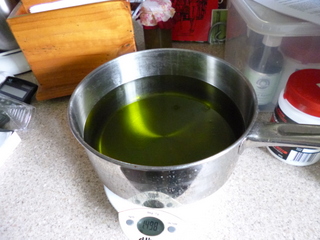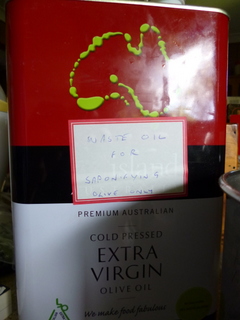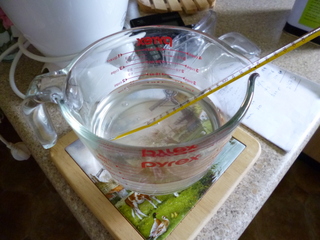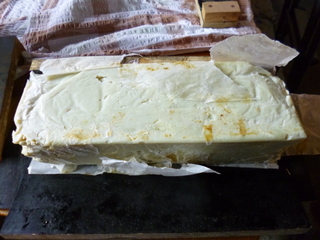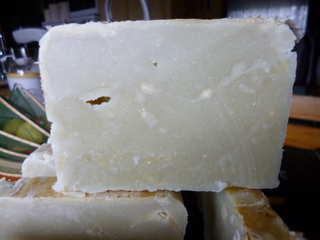The disposal methods for the oil that comes out of your deep fryer or whatever else you cook your chips in are fairly limited. It can be environmentally nasty if it gets into the waste water stream and be very difficult to extract so they recommend you put it back in the bottle you bought it in and toss it in the rubbish. But then it still goes into landfill. Biodiesel is an option, but if you are anything like us it would take months before you got enough biodiesel for a run down to the local shops. As you’ve probably guessed from the title of this article, the way to go is to make a useful product out of a waste one: make soap from waste vegetable oil!
The first bit of information you MUST have is the type of vegetable oil you want to make soap out of. We use generally either Australian olive oil or occasionally rice bran oil so for us it was pretty easy. So the big hint being from now on is to only use single oil types for deep frying or other activities where you may want to recover the oil. It can be almost impossible to work out what is in the generic “vegetable oil” bottles and if you have been using the oil to cook roasts or whatever, animal fat will also impact on the amount of caustic soda (also called “lye”) you need to make the soap.
If you do know the makeup of the oil you want to saponify there are lye calculators on the net that you can plug your numbers into and they will tell you how much lye you need for a givenbatch of oil. Otherwise you may have to make an educated guess, but if you do go that way, leave a bit of the caustic soda out so that the chance of unreacted caustic soda remaining in the soap is reduced.
To use up our oil I wanted to make pure castile soap, which is traditionally olive oil, lye, some water and not much else. While tooling around looking at formulations I found one that had 5% of the oil substituted with castor oil to improve lathering so I decided to use that (bad idea) but more of that later. The grade of olive oil will also affect the soap, virgin or extra virgin olive oil usually used in cooking gives a yellow to green soap while the pomace grade olive oil usually used in soapmaking gives a whiter soap.
I worked out the formulation to fit our soap mould exactly so below the first formulation is based on a kilo of oils to make it easier to calculate the right amount of soap for your mould and the second one is resized for our mould. The ratios are the same in both formulations.
The formulation has a built in superfatting ratio of 7% ie there is only enough caustic soda in the formulation to react with 93% of the oil, giving a soap that is kinder on the skin.
Olive oil 950gm 1498.6gm
Castor oil 50gm 78.9gm
Caustic Soda 124gm 195.6gm
Water 250gm 394.4gm
To start out, add the caustic soda to the water (which should be in a glass or stainless steel bowl, not aluminium) and stir to dissolve. It is nasty stuff so wear gloves and eye protection and it also gives off irritating vapour so do it outside with the wind behind you. The caustic soda solution will heat up so you need to allow it to cool down to 40°C, putting it in a cool water bath will speed up this process. Keep this stuff away from children!
While the caustic soda solution is cooling put the oils into a stainless steel pan and heat them up to 40°C as well. Once both liquids are at temperature the process is simple (I thought), put a stick mixer into the pot containing the oil and then slowly add the caustic solution until it is all in, mixing the whole time. Then continue to mix with the stick mixer until the soap batch gets somewhat thicker. The thickening may take 5 minutes up to 20 minutes and then you pour it into your mould, insulate it with a layer of towels and let it sit for 24 hours to complete the reaction. That was the theory.
In practice, I had gotten about two thirds of the caustic solution in when the thing went damn thick, like starting to solidify! Unfortunately there are no photos of this part of the process although photos of the panic on my face would have been pretty funny. In the soap making world this process of premature thickening up is called “seizing”. When it happened it became a mass panic to get the rest of the caustic solution in and mixed, and then the soap mix into the mould before the whole damn lot went solid! I did manage it sort of and the soap looks OK but there are a few small pockets of caustic solution in the finished soap. After a bit of research it turns out that soaps with 5% or more castor oil in them can seize on manufacture. I wish I’d read that first! Anyway, the next batch will be all olive oil.
Once demoulded and cut up the used oil soap doesn’t look to bad, it has a nice (I think) light yellowy green colour and seeing as there was not time to add any essential oil smelly stuff it just smells like. Um...well, soap. Due to uneven mixing there may be some areas that are a bit harsher than others so I will need to be careful when trialling it, but even if it is a bit rough on hands it could still be grated up and used to make clothes washing powder. That could be a topic of conversation at your next dinner party – “Can you believe I washed these clothes using waste cooking oil?”
This method is called the Cold Process (CP) for soap production and once the soap has reacted, set, been demoulded and cut into bars it needs to sit for at least a month to let the soap making reaction run to completion. If you do want to use the finished soap in washing powder the mix that I have tried and used effectively is –
Soap 50%
Washing soda 25%
Borax 25%



